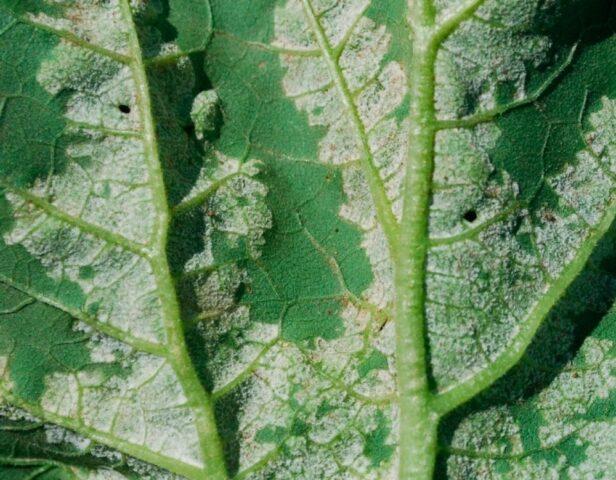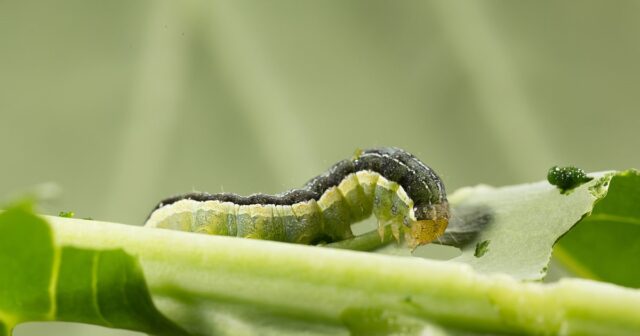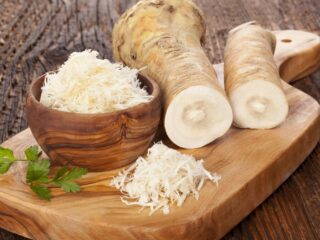Content
The “causticity” and “hotness” of horseradish makes it inedible for most pests, and the phytoncides contained in the tissues effectively destroy almost any pathogenic microflora. But it is impossible to say that horseradish diseases and damage by insects are an impossible phenomenon. The plant can be seriously damaged and even die from this, so it is important to be able to identify the problem and know how to deal with it before the process goes too far.
Horseradish diseases and control methods
Most often, the crop is affected by fungal diseases. To notice the problem at an early stage of development, when it is much easier to deal with it, it is recommended to inspect the plantings at least once a week.
Horseradish ascochyta blight
The first symptom of this disease is brown spots covering the leaves. Gradually they begin to increase in size, and a yellowish “edge” appears. The affected tissues are covered with a layer of mycelium, and the horseradish rosette becomes a source of spread of the disease. If nothing is done, the leaves quickly turn completely brown, dry out, and then the rhizome also dies.
To prevent the disease, it is critical to observe crop rotation, deep loosening or digging up the soil and thoroughly removing plant debris from the beds. Any fungicides, even “classic” copper sulfate and Bordeaux mixture, will help cope with ascochyta blight. The solution prepared according to the instructions is sprayed onto the horseradish leaves and the soil in the garden bed. Treatments are repeated every 7-10 days until the symptoms of the disease completely disappear.

Ascochyta blight is a disease that can be transmitted through planting material when horseradish is propagated by seeds.
White rot
A disease typical of many garden crops. Horseradish is not immune to it either. Fungal spores are transmitted not only through direct contact, they are carried by the wind, and many weeds become “intermediate hosts.” The causative agent of the disease is also preserved in planting material.
The risk of infection with white rot (sclerotinia) increases when the beds are “crowded” and the substrate is oversaturated with nitrogen. Also, the development of the disease is provoked by frequent rains, constant waterlogging of the soil, and its acidification.
The leaves and rhizomes of horseradish affected by this disease become covered with a whitish “cotton-wool-like” coating, quickly lose their tone, and stop developing. Gradually, its layer thickens, small black “speckles” (clusters of fungal spores) appear. The tissues under the plaque soften, turn black, become slimy to the touch, and completely rot.
Any fungicide is suitable to combat this disease.But the best results are demonstrated by the drugs Rovral, Ordan, Ridomil-Gold, Acrobat-MC. The frequency of treatments and the intervals between them are determined according to the instructions.

Horseradish leaves and rhizomes affected by white rot fungus become unsuitable for food
Verticillium wilt
The disease is caused by a fungus that lives in the soil and penetrates the rhizomes through surface microdamages. It spreads quickly throughout the plant's vascular system. Horseradish leaves lose their tone, wither, the entire above-ground part quickly dies, and the roots decompose.
To make sure that this disease is the reason for the deterioration in the appearance of horseradish, it is necessary to make several sections of leaf petioles or rhizomes. There should be noticeable black dots - areas of necrotic tissue formed as a result of blockage by the mycelium that causes Verticillium wilt.
There are no ways to combat this disease yet. Having discovered verticillium, the affected rosettes are dug up as quickly as possible. The soil in the garden bed is disinfected by spilling it with a 3-4% solution of copper sulfate or dark crimson solution of potassium permanganate. At the end of the season, the soil is dug up, generously sprinkled with dolomite flour or crushed chalk.

Horseradish dug out from the garden and infected with verticillium must be destroyed as quickly as possible.
Belle (downy mildew)
When affected by downy mildew, rapidly increasing pale green or greenish-yellow spots appear on the front side of horseradish leaves.The underside is covered with a coating - initially it is whitish or grayish, similar to scattered flour, but gradually “thickens” and changes color to gray-purple, turning into a solid layer.
If you do nothing and allow the disease to develop, the leaves gradually turn brown, dry out and die. The rhizomes become very small and become loose and soft inside.
When downy mildew is noticed at an early stage of development, even folk remedies, for example, a solution of potassium permanganate, baking soda, table salt, kefir or whey with the addition of iodine, have a good effect. In severe cases, only copper-containing drugs will help cope with the disease.

Effective prevention of horseradish downy mildew - pre-treatment of planting material with fungicides
Horseradish pests and ways to combat them
There are few truly dangerous pests for horseradish that can destroy plants completely. But almost all insects that attack it are voracious, so they can cause significant damage to plantings in a short time.
Wavy flea beetle
A small (2-3 mm in length), almost indistinguishable to the naked eye pest of horseradish. The color is predominantly black, with a glossy metallic tint, with longitudinal golden-yellow stripes running down the back. The wavy (cruciferous) flea beetle overwinters in plant debris or compost, manure heaps, and lays eggs there or in the surface layers of the soil.
Around mid-spring, as soon as the snow melts, the pest emerges from its hiding place. Its food is any plants from the Cruciferous family, both wild and “cultivated”.Therefore, to prevent the spread of the wavy flea beetle throughout the garden, planting horseradish and other plants that are interesting to the pest (radish, radish, cabbage, daikon, watercress) are placed away from each other.
In less than a week, leaves attacked by the pest turn into a kind of sieve. The wavy flea beetle then moves onto the stems, eventually turning into a pest of horseradish roots. Photosynthesis and other vital processes for the plant “go astray” and it dries out.

Trying to collect wavy flea beetles from horseradish leaves by hand is useless
How to fight caterpillars (cabbage moth) on horseradish
Adult cabbage moths are brownish or dirty yellow moths with a wingspan of about 3 cm and darker stripes on them. Female pests lay eggs on the underside of horseradish leaves in late May or early June. After about a week or a week and a half, yellow-green-gray caterpillars hatch and attack the beds en masse. In just 3-4 days, pests eat the horseradish leaves, leaving only veins, and the plants dry out.
The peak activity of cabbage moth caterpillars lasts for 3-5 weeks - the exact period depends on the weather. Horseradish leaves are successively “infested” by several generations of pests. Then they turn into pupae, “weave” cocoons and begin to prepare for winter, seeking shelter in plant debris or in the surface layers of the soil.

Most often, the cabbage moth attacks plantings of horseradish, cabbage and other Cruciferous crops in Siberia, the Far East and the Caucasus region
Cabbage bug
As a rule, there are no problems with the detection and identification of this horseradish pest. This is a fairly large (8-10 cm in length), flat insect with a black and red color. The cabbage bug becomes active as soon as the temperature reaches above zero at night.
Female pests lay eggs on the underside of horseradish leaves. The larvae hatching from them feed on plant juices and gnaw off the leaves themselves. The tissues first turn pale, then turn yellow, and eventually become discolored almost to the point of transparency. If the pest is not controlled, horseradish leaves become covered with necrotic spots, turn brown and die.

The peak activity of cabbage bug larvae occurs in June; this horseradish pest is especially “zealous” if the weather is hot and dry
Babanukha
This pest is also known under the names “cabbage leaf beetle” and “horseradish leaf beetle.” These nicknames clearly define which garden crops constitute its main “diet”. In addition to horseradish and cabbage, babanukha can attack horse sorrel.
The pest is a small (3-4 mm), round bug with a back painted glossy green. Adults overwinter mainly in plant debris in the garden bed and come to the surface in the first half of April. First, they feed on weeds from the Cruciferous family, then the pest “switches” to horseradish and cabbage, eating leaves until they become a “skeleton” of veins.

Rainy, cloudy weather is especially favorable for Babanukha.
How to protect horseradish from pests
Without knowing how to treat horseradish against pests - folk remedies or chemicals, you need to take into account the degree of neglect of the problem. When insects have already bred in large numbers, or during “mass” attacks, insecticides are used to treat horseradish against pests. The frequency of procedures and their frequency are determined according to the manufacturer's instructions. However, it must be taken into account that many of these drugs, if sprayed incorrectly against horseradish leaves against pests, are dangerous to human health, domestic animals and the environment. Therefore, it is easier to prevent insects from attacking the beds. Simple preventative measures will help with this:
- High-quality plant care. Proper watering and fertilizing are especially important to increase horseradish resistance to pests.
- Cleaning the beds in the fall from plant and other debris.
- Deep loosening of the soil in preparation for winter.
- Regular weeding. It is imperative to get rid of cruciferous weeds.
- Planting nearby plants whose smell is unpleasant to insects. You can also treat horseradish leaves against pests with decoctions and infusions based on them.
- The use of purchased and homemade glue traps.

By removing plant debris from the garden bed, the gardener destroys many spores of disease-causing fungi, eggs and larvae of pests
Conclusion
Horseradish diseases, as well as damage by pests, are rare occurrences, but the plant is not immune from them. Each such problem has its own characteristic symptoms that allow it to be correctly identified.Most of them can be dealt with and the health of the plant can be restored, especially if the development of the disease or pest attack is noticed at an early stage.









How to waste caterpillars on horseradish leaves